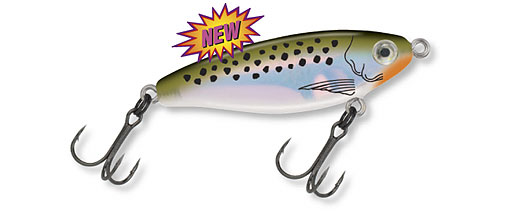FRANK SARGEANT
Published: Nov 30, 2001
Literally thousands of makes of artificial lures have come – and rapidly gone – in the past 100 years on the U.S. market. Just about every angler believes he can invent the ultimate lure, and a lot of them have tried. But for every “Banjo Minnow” – a phenomenally successful lure due to television marketing – there are hundreds of overnight flops. Only a few lures survive the test of time and suspicious fish. If inshore saltwater anglers were to pick a set of classics – can’t-fail lures they’ll always fall back on when things are tough – just which would be included? The list probably would be different for every angler. But some of the favorites seem to grace just about every tacklebox along Florida’s coasts.
The venerable Mirrolures, in dozens of models, are surely among the best-known of all plugs, and are made by L&S in Largo. The 52-M is probably the all-time favorite among slow- sinking lures; it’s very effective for anything from tarpon to snook to trout. The 5M, with the front prop removed, is a favorite among topwater anglers. The new Top Dog Junior now might have edged the 5M in popularity, however, because it casts farther and makes more noise. The floating Rapala, in sizes 11 and 14, is an enormously successful lure, particularly in the creeks in winter for snook.
It’s also a great lure on the flats on dead calm days, when heavier, noiser plugs spook the fish. The Johnson Silver Minnow, the single-hook weedless version in gold finish, is one of the most popular of all redfish lures, effective even in very shallow water for those who learn to put their reel in gear and start cranking just before the lure hits the water. The half-ounce size is most popular with flats anglers. An Old Favorite Less used today but still a favorite among old-timers is the Reflecto spoon in size 3. This bright chrome spoon is a deadly lure for giant snook. It’s the only lure used by some old pros such as former MFC commissioner Don Hansen and Everglades guide Jim Conley.
The Heddon Spook has been a topwater favorite among anglers chasing snook and lunker trout. It’s a “stick bait” with no built-in action, but an angler who knows how to “walk the dog” by twitching his rod back and forth can bring the lure to life. Jigs of all types are assuredly inshore classics. Most anglers today prefer plastic-tailed jigs, and there are dozens of companies making good ones, including one in Tampa, Bubba’s, as well as national companies such as Berkley. The advantage with jigs is that light heads with large tails can be fished in very shallow water.
And if the fish are deeper, you add progressively larger lead heads to get the lure deep, even in strong currents. For trout, many anglers prefer “grubtail” jigs, which stand up to repeated bites without damage. For snook and reds, swimmer-tail jigs seem to be more effective. And a weird little jig without a tail, Doc’s Goofy Jig, is one of the best pompano lures of all time. Not all the great lures have been around a long time. The new generation includes some that seem destined to be classics.
Near the top would have to be plastic shrimp imitations such as the DOA. This lure, fished just as you would a live shrimp, is amazingly effective, even for anglers who have trouble using other types of artificials. You simply cast it out and let it drift with the current until you feel a “tap,” then set the hook. It’s No. 1 with captain Mel Berman of WFLA, 970 AM, and among many other anglers. Another lure from DOA, a plastic mullet called the Baitbuster, is a favorite for summer tarpon with captains such as Mike Talkington of Plant City and James Wisner of Tampa. Filling A Special Niche Soft jerkbaits are also relatively new in saltwater, and highly effective – a staple for captain Fred Everson of Apollo Beach, among others. Included are models such as the Slug-Go, Fin-S and Jerkworm. All are Texas-rigged, hiding the hook inside the soft plastic body until a fish strikes.
The action is super, and the lures are totally weedless, making them a great choice in loose grass; snook, reds and trout eat them readily. They’re usually destroyed by one good fish, but replacement bodies are inexpensive. Tube lures also fill a special niche, especially those such as the Berkley Power Tubes, which include a fish-attracting smell. Captain Dave Markett of Tampa uses these tubes by the pound, mostly in a pumpkin or tan color that’s somewhat shrimp-like. The disadvantage of the tubes is most require you to cut off the jig head to install a new tube.
Yo-Zuri makes a series of wonderfully life-like lures that catch anything that swims in inshore waters. The Crystal Minnow is particularly effective. Unfortunately, these are among the most expensive of all lures, at prices of $8-$10 each. My personal favorite these days is probably the Spit-n-Image in silver and green, which is a fair imitation of a rather fat whitebait. This topwater is easier to work than a Spook, casts a mile and has hooks that are extremely sharp and very strong.
It’s the one lure I usually carry when I’m going to wade well away from the boat and won’t be close to a tacklebox. Whether you choose an old favorite or one of the hot new artificials, success is still a matter of learning to work the lure perfectly, fishing in the right place at the right time, and having enough confidence in your offering to stick with it. No lure can be successful if it’s tucked away in your tacklebox most of the time.
- Jay Mastry - March 26, 2024
- Captains Corner, Gorta - March 23, 2024
- Dave Zalewski - March 12, 2024











